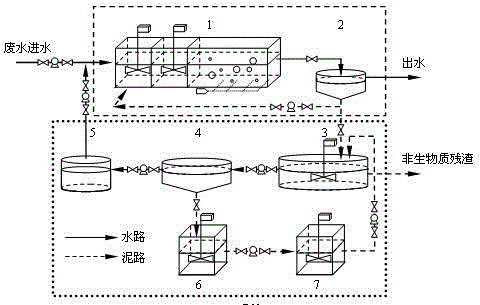Biomass-emission-free method for enhancing biological wastewater nitrogen and phosphorus removal effect
A biomass and biological phosphorus removal technology, applied in chemical instruments and methods, water/sewage multi-stage treatment, water/sludge/sewage treatment, etc., can solve problems such as easy corruption, secondary pollution, high organic matter content, and achieve The effect of enhancing the effect
- Summary
- Abstract
- Description
- Claims
- Application Information
AI Technical Summary
Problems solved by technology
Method used
Image
Examples
Embodiment 1
[0020] Sewage directly enters the biological phosphorus and nitrogen removal reactor, and after biological phosphorus and nitrogen removal, the mud-water separation is carried out in the secondary settling tank, and the BCPC system is not installed. The phosphorus removal efficiency of the final sewage is 61%, the nitrogen removal efficiency is 53%, the biomass content in the discharged waste solid residue is 62%, and the effluent does not meet the first-class A discharge standard.
Embodiment 2
[0022] Sewage directly enters the biological phosphorus and nitrogen removal reactor, and after biological phosphorus and nitrogen removal, the sludge-water separation is carried out in the secondary sedimentation tank; part of the separated sludge is returned to the sewage biological phosphorus and nitrogen removal reactor, and the other part of the sludge enters the biological Substance anaerobic converter, the residence time of biomass in the anaerobic converter is controlled to be 21 days, and the pH value is 8. After the reaction product passes through the solid-liquid separation tank for solid-liquid separation, the liquid is transported to the liquid carbon source storage tank to supplement the carbon source concentration in the influent; the solid matter enters the primary treatment tank, and the H 2 o 2 The usage amount is 0.2 times of the biomass, and then enters the secondary treatment pool, the usage amount of the secondary treatment agent is 0.3 times of the bioma...
Embodiment 3
[0024] Sewage directly enters the biological phosphorus and nitrogen removal reactor, and after biological phosphorus and nitrogen removal, the sludge-water separation is carried out in the secondary sedimentation tank; part of the separated sludge is returned to the sewage biological phosphorus and nitrogen removal reactor, and the other part of the sludge enters the biological Substance anaerobic converter, the residence time of biomass in the anaerobic converter is controlled to be 30 days, and the pH value is 8. After the reaction product passes through the solid-liquid separation tank for solid-liquid separation, the liquid is transported to the liquid carbon source storage tank to supplement the carbon source concentration in the influent; the solid matter enters the primary treatment tank, and the H 2 o 2 The usage amount is 2 times of the biomass, and then enters the secondary treatment pool, the usage amount of the secondary treatment agent is 1 times of the biomass, ...
PUM
 Login to View More
Login to View More Abstract
Description
Claims
Application Information
 Login to View More
Login to View More - R&D
- Intellectual Property
- Life Sciences
- Materials
- Tech Scout
- Unparalleled Data Quality
- Higher Quality Content
- 60% Fewer Hallucinations
Browse by: Latest US Patents, China's latest patents, Technical Efficacy Thesaurus, Application Domain, Technology Topic, Popular Technical Reports.
© 2025 PatSnap. All rights reserved.Legal|Privacy policy|Modern Slavery Act Transparency Statement|Sitemap|About US| Contact US: help@patsnap.com

